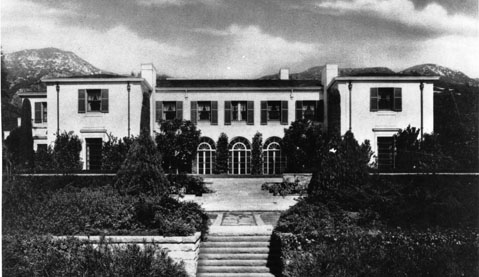The Founding of Westmont
In 1945, Montecito Became Home to the Christian College

Westmont College is largely the result of one woman’s vision. In August 1937, Ruth Kerr awoke from a sound sleep. God had spoken to this deeply religious woman and had told her the time was right to open a Bible school. This was the beginning of Westmont College.
Ruth Kerr became president of the Kerr Glass Manufacturing Company (anyone who does canning or preserving should recognize the name) in 1930, five years after her husband’s death. Using funds from her successful company, she opened the Bible Missionary Institute in Los Angeles in 1937 with 72 students and 16 staff. Two years later, the school added some liberal arts courses and changed its name to Western Bible College. The metamorphosis continued the following year under the leadership of Dr. Wallace L. Emerson. The school moved to larger facilities in Los Angeles, became a four-year liberal arts college built upon Christian principles, and changed its name one last time to Westmont College. Why Westmont? According to Emerson, because the “name sounded all right.” Classes began in the fall of 1940 with a faculty of 33 and with 85 students.
These were lean years. The library was initially developed by purchasing volumes at used book stores and estate sales. Faculty was not always paid; at one point Dr. Emerson sold his car to help pay his teachers. Still, enrollment grew during the war years, with more than 300 students attending by 1946. The college had outgrown its campus, and in 1944, Westmont purchased a former golf course in Altadena to develop a new home. Neighbors objected; they wanted the course to become a public park, and there were concerns over traffic, parking, and noise. There may also have been a racial element involved, for Westmont enrolled students of all races, and the proposed new campus was in a strictly all-white neighborhood.
The county zoning commission refused Westmont the necessary zoning change, and the school found itself without a home, for it had already sold the old L.A. campus. Bolstered by funds from the sale of the Altadena land, the search for a new site continued. It led school representatives to Montecito, where, in 1945, they purchased the 125-acre estate El Tejado from Charles Holland for $125,000. The estate was the former home of the Dwight Murphy family, and the large main house had been designed by Reginald Johnson, architect of the Biltmore Hotel and Santa Barbara’s main post office. The house became Kerrwood Hall. The school also leased or bought a number of other properties for dormitories and trucked in Quonset huts from Oxnard for more space. One newly hired faculty member was told to bring his housing with him; he lived in a trailer for four years.
The college entered a period of growth and expansion under the 18-year presidency of Dr. Roger Voskuyl, who arrived in 1950. He pushed the hiring of more doctorates for faculty. The long-sought dream of accreditation was achieved in 1958. The school’s physical plant continued to grow, and by 1960 enrollment stood at almost 500 students. Growth accelerated in the 1960s. By the end of the decade, more than half of the faculty held doctorates and the student body had grown to almost 900.
Today, Westmont College occupies a campus of more than 110 acres with a student body of more than 1,300. More than 80 percent of the faculty are doctorate holders. The college remains dedicated to its mission of “…serving God’s kingdom by cultivating thoughtful scholars, grateful servants, and faithful leaders for global engagement with the academy, church, and world.”



